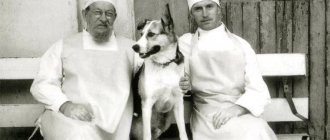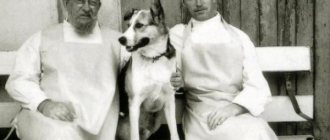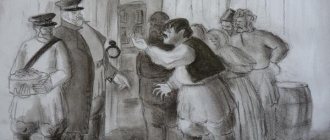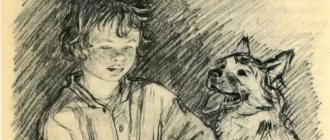- Essays
- On literature
- Bulgakov
- Characteristics and image of Doctor Bormenthal
The story of the Soviet writer M.A. Bulgakov. "Heart of a Dog" was written in 1925. The plot of the work is completely fictional. Only the description of Moscow life and the changes that occurred in society after the revolution is real.
One of the central characters of the story is Ivan Arnoldovich Bormental. He is an attractive young man with an athletic build. While studying at the Medical University, he was a student of Professor Preobrazhensky. Then came work at the professor’s department. After graduating from university, Ivan Arnoldovich received an offer from Philip Philipovich to become his assistant.
Having become an assistant to the “luminary” of medicine, Dr. Bormenthal took part in an experiment conducted by the professor for scientific purposes. During the experiment, Preobrazhensky, with the help of Ivan Arnoldovich, transplanted some organs of a deceased person into a stray dog. The young doctor carefully monitors the results of the experiment and makes all the necessary notes.
The human organs transplanted into the dog successfully took root. The dog Sharik gradually transformed into a person with the natural surname Sharikov. The scientific experiment could be considered successful if not for the behavior of the patient under his care. Polygraph Poligrafovich did not recognize any moral and ethical standards.
The intelligent professor Preobrazhensky, who does not recognize violence, tried as best he could to explain to Sharikov the norms of behavior accepted in a decent society. But the ward reacted painfully to the comments. And his behavior became worse and worse. Bormenthal, devoted to his mentor, tried to use force to explain to the dog-man how he should behave. The young doctor wants to protect the elderly and distinguished professor from the cheeky and boorish behavior of the operated dog. Despite his good upbringing, Ivan Arnoldovich is ready to use brute physical force to rein in the unruly hooligan.
Tired of Sharikov's ugly antics, Preobrazhensky and Bormenthal make the only correct decision. A dog transformed into a human through surgery is returned to its original state.
Bormenthal showed himself to be an open and decent person who values moral principles.
Film adaptations
Bulgakov's story "Heart of a Dog" was not popular among filmmakers. The first film based on the work was shot in collaboration between Italian and German authors under the direction of director Alberto Lattuada. The role of Dr. Bormenthal in the film was played by actor Mario Adorf.
Actor Boris Plotnikov in the film “Heart of a Dog”
The book was filmed once in the Soviet Union. In the project, released in 1988, Dr. Bormental was embodied.
We can talk about what kind of heart Sharikov has - a dog's or a human's - in different ways, depending on the initial setting. Physiologically, it was a dog’s heart, but Professor Preobrazhensky and Bormenthal are not arguing about that. The question is whether Sharikov exhibits typically human character traits or whether they are part of his canine past. Of course, there are many people like Sharikov, which testifies in favor of Professor Preobrazhensky, especially since the man whose pituitary gland was placed in the dog had a disgusting character, was a thief and an alcoholic. Another thing is that, at its core, the human heart is completely different. After all, the debate is actually about whether human nature is positive or not. It can be resolved this way: initially it is inevitably positive, otherwise man could not have formed as a species, but man himself placed himself in conditions contrary to his nature, and his qualities and properties were distorted under the influence of the environment he himself created. In the framework of the dispute between Professors Preobrazhensky and Bormental, the professor is more right.
- M. A. Bulgakov came to literature already during the years of Soviet power. He was not an emigrant and experienced first-hand all the difficulties and contradictions of Soviet reality in the 1930s. His childhood and youth were connected with Kiev, and the subsequent years of his life with Moscow. To Moscow...
- New! watch in full
M. Bulgakov did not see the story “The Heart of a Dog,” written in 1925, published, since it was confiscated from the author along with his diaries by OGPU officers during a search. “Heart of a Dog” is the writer’s latest satirical story. Everything, that…
SHARIKOV is the hero of the story by M.A. Bulgakov “Heart of a Dog” (1925). At the heart of this, according to the writer, “monstrous story” is a plot motif that goes back to the romantics (“Frankenstein” by M. Shelley), presented later by H. Wells (“The Island of Doctor Moreau”), by the Russians...
Bulgakov’s story “The Heart of a Dog,” subtitled “A Monstrous Story,” was not published during the writer’s lifetime. It was first published in 1968. (“Student”. London. NN 9, 10; “Fringes”. Frankfurt. N 69). In the USSR it was published in the magazine “Znamya”...
Without exception, all of Bulgakov’s works literally fascinate the reader, posing the most difficult questions, which are not so easy to solve. Bulgakov’s story “The Heart of a Dog” makes you think about man’s place in the world, about responsibility...
History of creation
The story “Heart of a Dog” was conceived by the author back in 1925. Bulgakov spent three months working on it. Difficulties in publishing works due to censorship and the author’s uncertainty did not leave hope for the publication of the story. It was repeatedly copied by hand and reprinted to pass from hand to hand among Bulgakov’s close friends and acquaintances. Authorities learned about the “Heart of a Dog” only in 1926. This happened by accident. The writer was searched by the OGPU, whose employees discovered the manuscript.
The work traveled through the archives of the Soviet intelligence services and remained inaccessible to the public for a long time. There are several editions of the story that are stored in the Russian State Library. Their analysis helps to assess the degree of complexity of the publication history of the work.
The first edition contained a depiction of the political realities of the Soviet Union and references to specific government officials. The author independently submitted one of the versions of the manuscript to the almanac “Nedra” for publication. The work gave the impression of being unreliable. He himself banned the publication of the story, calling it a sharp depiction of modernity. Readers learned about the fate of Bulgakov's characters during the era of perestroika, when censorship weakened.
The plot of the story combined elements of fantasy and realism. It contained criticism of government, which is why it gained popularity in the 1960s. The publication of the story in the 1990s elevated him to the heights of world literature. Bulgakov described the tragedy of the people through the conflict of characters who could not find mutual understanding and a common language. The story has three main characters. The story is told in the form of a monologue by a dog that was experimented on. The events are covered in the diary of Dr. Bormenthal.






